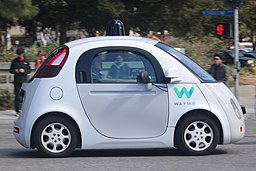If you enjoyed our last installment of the best GEICO commercials you should enjoy these gems just as much, if not more!
Can Driverless Cars be Trained Virtually?
Self-driving vehicles are the future. From Tesla’s fully electric self-driving semi to Intel’s Mobileye assisted driving system, vehicle manufacturers are embracing this rapidly advancing technology.
But is the technology really perfected enough for us to see fully automated cars on roads today?
The RAND Corporation recently asked, “How many miles of self driving would it take to demonstrate autonomous vehicle reliability?”
They found that self-driving cars need to travel at least 11 billion miles of test time before complete confidence in safety can be reached. Given that large number, that can translate into tens or even hundreds of years of testing.
Analysts and researchers agree some innovative testing strategies are necessary. Typical, real world testing just isn’t practical to reach the time needed to say definitively that self-driving cars are safer than those operated by humans.
Finding Alternative Testing Methods
Companies are now finding ways to model environments to test assisted driving systems before they are testing in actual cars.
Notably, Parallel Domain is working toward accelerating training times by creating software that builds simulations quickly. Testing is difficult to coordinate while keeping safety a top priority. Creating a virtual testing environment makes pedestrian and passenger safety a non-issue.
Vehicle companies creating their own simulations can be cost prohibitive and extremely slow. Developers can take weeks to create a few city blocks. However, Parallel Domain was able to create a simulation that creates exquisitely detailed, hyper-realistic city blocks in minutes.
This is the solution the autonomous driving industry was looking for.

Unlike Parallel Domain, Waymo made this proprietary software to serve their own company’s fleet of self-driving cars. Therefore, unlike Parallel Domain, Carcraft is not available for use by other car companies. It seems Parallel Domain’s founder may have invented a niche service after all.
From Pixar to Large Scale Modeling for Autonomous Vehicles
Parallel Domain was founded by Kevin McNamara. He began building virtual environments for Pixar films and later at Microsoft Games for video games like Crackdown 3 and Sunset Overdrive. After his time there, he moved to Apple’s Special Projects Group working on simulations for autonomous software.
When McNamara saw an opportunity, he went for it. Through Costanoa Ventures and Ubiquity Ventures, he managed to raise $2.5 million to start his new company. According to McNamara in an interview with Tech Crunch, “What we do is use computer graphics to try to accelerate the development of safe autonomous vehicles.”
The point is to do this all virtually in order to safely make mistakes and learn from them.
Essentially, Parallel Domain’s software uses real-world data from maps, along with generative models and growth algorithms, to create a virtual environment. Here, autonomous systems can learn to drive. Every aspect of the software is programmable and can be changed by researchers. Everything from terrain to road curvature is customizable. Pedestrians and time of day can be adjusted with the click of a mouse.
Parallel Domain already has their first customer: NIO, an auto driving vehicle startup out of China. The company currently only markets their vehicles in China. By 2020, however, they plan sell their cars in the United States. The cars are expected to only have some autonomous capabilities (think Tesla). Soon, other companies will likely join NIO in using this first of its kind technology.
The long-term vision by McNamara and his team is for Parallel Domain to work in tandem with real world tests. The simulation would act as a fast-forward button for testing. Car companies would be able to order a “package” simulation that includes millions of miles of diverse roads to drive on.
For auto companies, they would have the benefit of accessing large testing environments at a fraction of the cost. Thereby, more autonomous vehicle companies would have a chance against large competitors like Tesla to get their ideas tested. Software like Parallel Domain enables companies to develop products safely and quickly.
“Our software automatically generates the environments and scenarios that feed into simulators, making it safe and fast for autonomous vehicles to learn from their mistakes, accelerating time to safety for all vehicles.”
Kevin McNamara, CEO at Parallel Domain
With software like Parallel Domain’s, reaching 11 billion miles will be an attainable goal.
A Final Question
One thing needs to be considered: Will the public really trust virtual training in self-driving cars? In March of 2018, one of Uber’s autonomous cars was involved in a fatal accident – the first in history. It damaged the credibility of the industry as a whole.
Although creating simulations to log and test autonomous driving systems is essential, it’s no substitute for real life driving. It’s clear that a multi-level approach to training will be both the most accepted and most efficient way to get self-driving cars on the roads faster.
Self-driving car companies and simulation makers seem to understand the importance of virtual and real-world testing. Let’s hope it goes a long way in creating trust in consumers.

